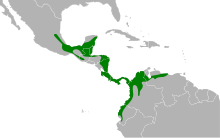Black-and-white owl
| Black-and-white owl | |
|---|---|

| |
| Scientific classification | |
| Domain: | Eukaryota |
| Kingdom: | Animalia |
| Phylum: | Chordata |
| Class: | Aves |
| Order: | Strigiformes |
| Family: | Strigidae |
| Genus: | Strix |
| Species: | S. nigrolineata
|
| Binomial name | |
| Strix nigrolineata (Sclater, PL, 1859)
| |

| |
| Synonyms | |
|
Ciccaba nigrolineata (Sclater, 1859) | |
The black-and-white owl (Strix nigrolineata) is a species of owl in the family Strigidae.[1][3]
Description
The black-and-white owl is a medium-sized owl with a round head and no ear tufts. It is between 35 and 40 cm in length and weigh between 400 and 535 grams. As for most owl species, females are usually bigger than males with an average weight of 487 g and 418 g respectively.[4] It has a striped black-and-white breast, belly, and vent. With the exception of a black-and white striped collar, the upperparts from the crown to the tail are a sooty black. The facial disc is mostly sooty black, with white "eyebrows" that extend from the bill to the collar. The beak is a yellow-orange colour, and the eyes are a reddish brown.[5]
Chicks are downy and white.
Juveniles have a whitish face, dark brown upper-parts and a white-barred black underside.[6]
Taxonomy
Formerly under the genus
Habitat
The black-and-white owl is mostly found in
Distribution
Its range extends from central
Behaviour
Foraging and diet
This neotropical bird is a nocturnal hunter and since most of its prey can fly, it forages mostly at the canopy level of its habitat. It will first examine its surroundings by perching on an elevated branch. Then it will make short, silent flights to catch its food.[9][10] Primarily insectivorous, the black-and-white owl prefers scarab beetles (Scarabaedidae) such as dung beetles and sometimes prey upon orthopterans and cicadas (Cicadidae).[9][10] Bats such as the Jamaican fruit bat (Artibeus jamaicensis) and other small rodents also make up a large part of its diet. Furthermore, it can occasionally feed on smaller birds like trushes and tanagers as well as amphibians.[7][9][10] It is also one of the only tropical owl species reported to capture barn swallows since those are easy to catch when roosting on nearby electric lines.[11]
Vocalization
Its call consists of a series of rapid, guttural, low calls, followed by a short pause and a low, airy call and a faint, short hoot. Occasionally, it is shortened to just the last two notes, leaving out the opening series.[5] Moreover, the female's call usually sounds louder than the male's and individuals make fainter "hoots" near their nest. Just like their parents, younglings can produce strident cries, but also communicate by clacking their beak.[4]
Reproduction
When the breeding season begins in March, the
Conservation status and threats
The black-and-white owl is classified as "Least Concern" on IUCN's Red List even if its populations are decreasing.[13] Mexico's population in particular observed a decline of 50% in the last century which has made the species a big concern for the Partners in Flight association.[7] This bird of prey's main threat is the loss of its wetland and forest habitats which are progressively converted into agricultural lands.[4][7] Human proximity also causes their populations to decrease.[4]
References
- ^ . Retrieved 24 November 2022.
- ^ "Appendices | CITES". cites.org. Retrieved 14 January 2022.
- . Retrieved 7 April 2011.
- ^ ISBN 978-0-8014-6428-7.
- ^ a b c d e Mikkola, Heimo (2012). Owls of the World. Buffalo, New York: Firefly. p. 333.
- ^ a b c "Black-and-white Owl". oiseaux-birds.com. Retrieved 14 October 2020.
- ^ .
- ^ JSTOR 4163480.
- ^ JSTOR 4513935.
- ^ JSTOR 1369226.
- S2CID 83657346.
- ^ Gerhardt, Richard P.; Gerhardt, Dawn McAnnis (1997). "Size, dimorphism, and related characteristics of Ciccaba owls from Guatemala". In Duncan, James R.; Johnson, David H.; Nicholls, Thomas H. (eds.). Biology and conservation of owls of the Northern Hemisphere: 2nd International symposium. St. Paul, MN: U.S. Dept. of Agriculture, Forest Service, North Central Forest Experiment Station. pp. 190–196.
- ^ International), BirdLife International (BirdLife (6 August 2018). "IUCN Red List of Threatened Species: Ciccaba nigrolineata". IUCN Red List of Threatened Species. Retrieved 14 October 2020.

